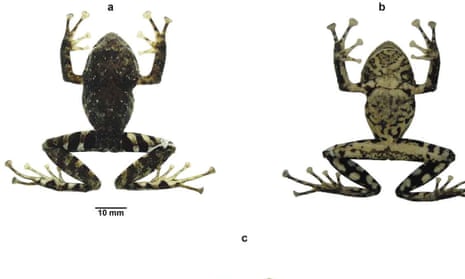Researchers in the misty mountains of the Ecuadorian Andes have discovered a new species of terrestrial frog and named it after the pioneering British rock band Led Zeppelin.
Pristimantis ledzeppelin, known in English as Led Zeppelin’s Rain Frog, was found by the scientists David Brito-Zapata and Carolina Reyes-Puig in the Cordillera del Cóndor, which straddles south-east Ecuador and north-east Peru.
The small frog, which has coppery-red eyes and a mottled, yellow, brown, black and orange skin, is a member of the huge and rapidly expanding Pristimantis genus. The genus comprises 569 species – 28 of which have been described in Ecuador in the past two years alone.

The new discovery is reported in the Neotropical Biodiversity journal and on the website of the Ecuadorian government’s National Biodiversity Institute.
Brito-Zapata and Reyes-Puig said all the specimens had been found “on shrub vegetation surrounding streams inside mature forest, where they perched on bush leaves”, between 1.7 metres and 3 metres above the water. Males of the species grow to about 2.4cm long, while one adult female was found to measure 3.6cm from snout to vent.
“The name honours Led Zeppelin and their extraordinary music,” the pair explain in the journal. “Led Zeppelin was a British rock band formed in London in 1968, one of the most influential bands throughout the 1970s, and progenitors of both hard rock and heavy metal.”
They warn that Pristimantis ledzeppelin risks being trampled underfoot as the rich biodiversity of its habitat is endangered by farming, logging, mining, disease and the climate emergency. They also note the species is unlikely to move elsewhere and will need protection.
“Due to the high endemism of the Cordillera del Cóndor, the new species here described is likely to be found only in this restricted area, therefore it is important to consider new long-term initiatives for small vertebrate conservation actions,” the researchers write.










